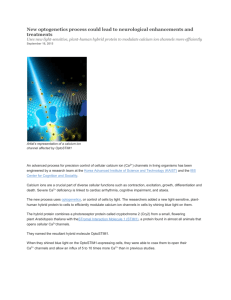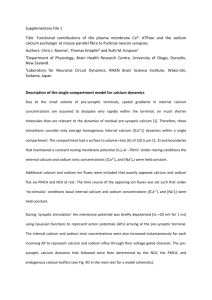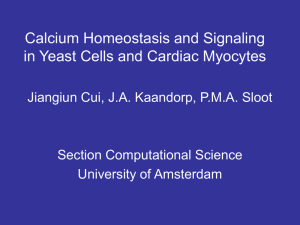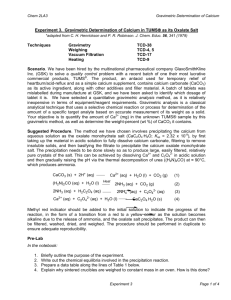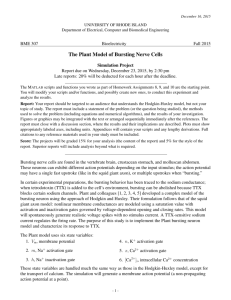calcium imaging in neuronal subcompartments using a genetically
advertisement
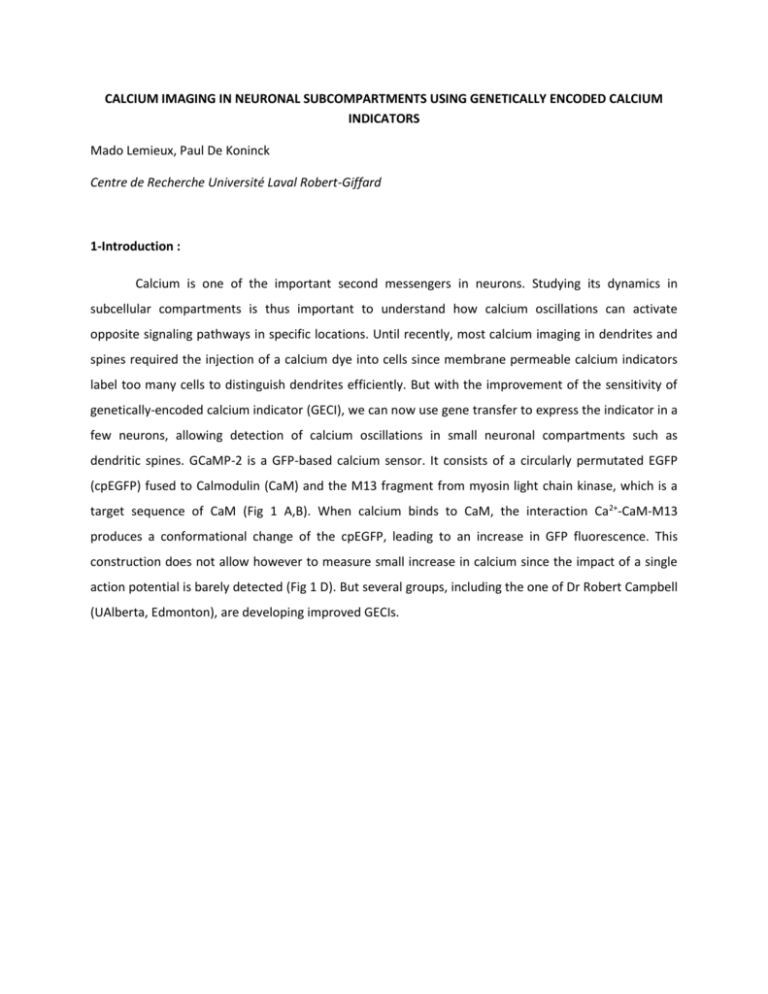
CALCIUM IMAGING IN NEURONAL SUBCOMPARTMENTS USING GENETICALLY ENCODED CALCIUM INDICATORS Mado Lemieux, Paul De Koninck Centre de Recherche Université Laval Robert-Giffard 1-Introduction : Calcium is one of the important second messengers in neurons. Studying its dynamics in subcellular compartments is thus important to understand how calcium oscillations can activate opposite signaling pathways in specific locations. Until recently, most calcium imaging in dendrites and spines required the injection of a calcium dye into cells since membrane permeable calcium indicators label too many cells to distinguish dendrites efficiently. But with the improvement of the sensitivity of genetically-encoded calcium indicator (GECI), we can now use gene transfer to express the indicator in a few neurons, allowing detection of calcium oscillations in small neuronal compartments such as dendritic spines. GCaMP-2 is a GFP-based calcium sensor. It consists of a circularly permutated EGFP (cpEGFP) fused to Calmodulin (CaM) and the M13 fragment from myosin light chain kinase, which is a target sequence of CaM (Fig 1 A,B). When calcium binds to CaM, the interaction Ca2+-CaM-M13 produces a conformational change of the cpEGFP, leading to an increase in GFP fluorescence. This construction does not allow however to measure small increase in calcium since the impact of a single action potential is barely detected (Fig 1 D). But several groups, including the one of Dr Robert Campbell (UAlberta, Edmonton), are developing improved GECIs. A B C V 83 I D 180 Y A 206 K REST M13 eGFP(149-238) eGFP(1-144) CaM D Fig 1. Structure and properties of GCaMP2. A) Representation of the domain structure of GCaMP2. B) Schematic topology of GFP-based Ca2+ probes. C) Fluorescence excitation and emission spectra of GCaMP2 (in vitro) in the presence of 1mM Ca2+ or 5mM EGTA. D) Amplitudes of GCaMP2 responses for individual hippocampal pyramidal cells in response to trains of action potential given at 83 Hz. Example single trial responses (right) from 2 cells to 1, 5, 10 and 40 action potentials. (Nakai et al., 2001; Mao et al., 2008). Since basal levels of fluorescence of most GECIs are low, a combined transfection with a protein enriched at postsynaptic densities (PSD), such as Homer, allows the identification of synapses and makes it easier to monitor synaptic Ca2+ oscillations (Fig 2A). Homer is consider as one of the scaffold protein of PSDs. It is known to interact, among others, with some metabotropic glutamate receptors (mGluRs), IP3 receptors as well as with another scaffold protein, Shank (Fig 2B) (Kim and Sheng, 2004; Tadokoro et al., 1999). A GCaMP2 mCherry-Homer 1c Overlay B Fig 2. Homer 1c as a postsynaptic marker. A) Hippocampal neuron in culture (13DIV) transfected with GCaMP2 and mCherry-Homer 1c using lipofectamine. Arrows point to synaptic sites. Scale bar: 5M. B) Schematic diagram of the organization of proteins at a mammalian excitatory synapse (taken from Kim and Sheng, 2004). 2-Objectives : -Imaging Ca2+ oscillations in cultured neurons using GECIs. -Detection of postsynaptic sites using morphological analysis of mCherry-Homer 1c images, tracking of their position in time, and analysis of the associated Ca2+ indicator fluorescence for each given synapse. -Analysis of the relative changes in Ca2+ by calculating F/F0. -Analysis of the relative changes in Ca2+ in different subcellular compartments: synapses, dendrites and soma. -Comparison of the response to a 0Mg2+/Gly and bicuculline stimulations. 3-Description of the experiment -Timelapse imaging: We will use hippocampal neurons in culture of 10 to 17DIV transfected with a GECI together with mCherry-Homer1c. Cells are imaged at room temperature with a 63x water objective (NA 0.95). For dual color imaging, we use an EGFP/dsRed filter set (Chroma, Bellows Falls, VT) and sequentially excite GCaMP2 (485nm 25x filter) and mCherry (565nm 25x filter) with a Lambda DG-4 equipped with a 175W Xenon lamp (Sutter Instrument, Novato, CA). Images are acquired using a CCD camera (CoolSNAP HQ, Photometrics). We will image spontaneous activity of the network in a standard imaging solution (1.2mM Ca2+/1.0mM Mg2+) and will use bath application of solutions that increase synaptic activity (0Mg2+/200M Glycine) or Bicuculline (10uM). -Image analysis: We will x,y align the images over time. We will identify synaptic regions on mCherry-Homer 1c images by detecting clusters of Homer, using a morphometric analysis designed in MatLab, and will track their position over time to monitor each synapse separately. We will then measure the intensity for both fluorophores, correct for background fluorescence and calculate the relative variations F/F0 at those synaptic sites. We will also compare the average synaptic Ca2+ response to the variations in dendritic and somatic regions. 4-References (Not complete) Hendel T, Mank M, Schnell B, Griesbeck O, Borst A, Reiff DF (2008) Fluorescence changes of genetic calcium indicators and OGB-1 correlated with neural activity and calcium in vivo and in vitro. J Neurosci 28:7399-7411. Kim E, Sheng M (2004) PDZ domain proteins of synapses. Nat Rev Neurosci 5:771-781. Mao T, O'Connor DH, Scheuss V, Nakai J, Svoboda K (2008) Characterization and subcellular targeting of GCaMP-type genetically-encoded calcium indicators. PLoS One 3:e1796. Nakai J, Ohkura M, Imoto K (2001) A high signal-to-noise Ca(2+) probe composed of a single green fluorescent protein. Nat Biotechnol 19:137-141. Tadokoro S, Tachibana T, Imanaka T, Nishida W, Sobue K (1999) Involvement of unique leucine-zipper motif of PSD-Zip45 (Homer 1c/vesl-1L) in group 1 metabotropic glutamate receptor clustering. Proc Natl Acad Sci U S A 96:13801-13806.







